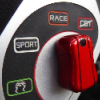Most of it is covered in Chris' Barcelona 24 prep blog. http://www.hofmanns..../archive/201108Would you like to explain how you did it?
With thanks to Winstar my charge intake temps have dropped from nearly 100degrees constant to 45 peak and astonishingly quick recovery rates.
LMAO I spent years working designing vehicle thermal management systems (VTMS) and I've given up commenting on this as there's just no point as everyone has an opinion none based on fact or real test data (even those selling the stuff) As for mass low rate then my CFD model of a VX with ears but no blockage for the IC predicts at 45m/s (~100mph) there is just enough flow to cool the charge for 300 bhp. You'll find efficiency and effectiveness are generally used interchangeably when people talk about after coolers even at oem level.The intercooler vs chargecooler debate fascinates me. If anyone's done any efficiency calculations I'd be interested? Otherwise as an (ex) engineer I'm probably still capable of working it out by myself if presented with enough data. The interesting thing is mass flow of air through the RHS turbo ear and through the intercooler and the mass flow of air through the chargecooler rad at the front. Haven't seen any evidence on here of anyone measuring that? Without wanting to be critical I find it interesting that there's lots of talk about IC and CC efficiency when what people mean is effectiveness. Without knowing the mass flow of the ultimate cooling medium you can't work out efficiency and you can't optimise effectiveness.
Edited by Winstar, 08 September 2016 - 07:52 PM.


















